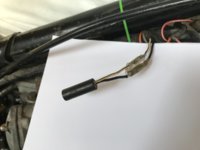After a quick look online some while ago I saw that single disk US versions have the disk on the right hand side. So, that that's where I fitted the better of two disks.
I bought this from Yambits
https://yambits.co.uk/xs650-brake-caliper-p-38993.html?osCsid=m0772h9afmvq663ntfo6vsft70 and realised it was meant to fit on the left at the rear. My callipers were both at the rear. After a quick look more carefully online I realise that most singe disks are on the right
at the front. Scratches head. Makes executive decision. Mine is going to be on the rear on the right. ("This is my xs650b. There are many like it … but this one is mine.")
The calliper can be "handed" by swapping the bolt and the stud. Easy.
But after a couple of hours of sweat trying to get either out I managed only to get the bolt out. But it was tight then loose all the way out. It took a while with Coppaslip working the thread backwards and forwards before I was happy. None of my sockets was deep enough to accommodate the stud and using a ring spanner only risked damaging the flatted bit of it.
There's a bloke up the lane with a Harley and he's always in his garage. He's the sort who has a long white beard and is never out of red overalls. So I trudged up the lane to share my problem with him. The stud thread was even tighter than the bolt to the point of casting doubt whether they could in fact be swapped over. The stud tightened up in the bolt hole and would go no further. Suffice it to say after some judicious measuring and some more Coppaslip and working of the threads we (he) ended up with a calliper that could be swapped either side with relative ease.
So thanks Harley guy. I'm popping along later with a bottle of red wine.
So far the caliper seems like a reasonable bit of kit. The original is not available so Yambits have had this remanufactured and I'm glad it exists. It comes with pads and the shims (the shims on their own are £15). It can be fitted with either the original metal brake line or apparently has been machine to accommodate a banjo.




